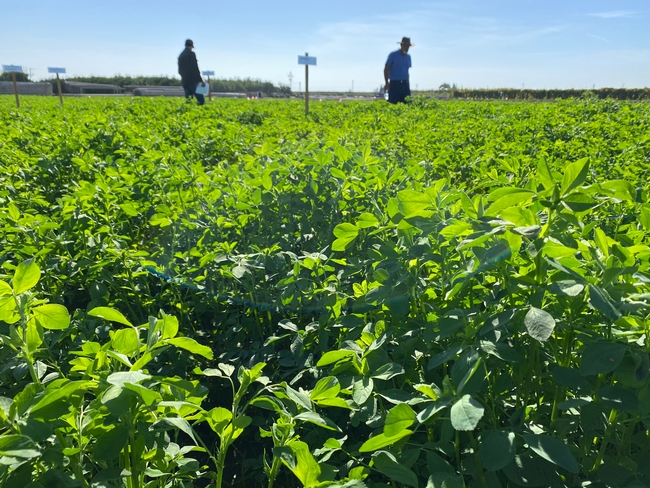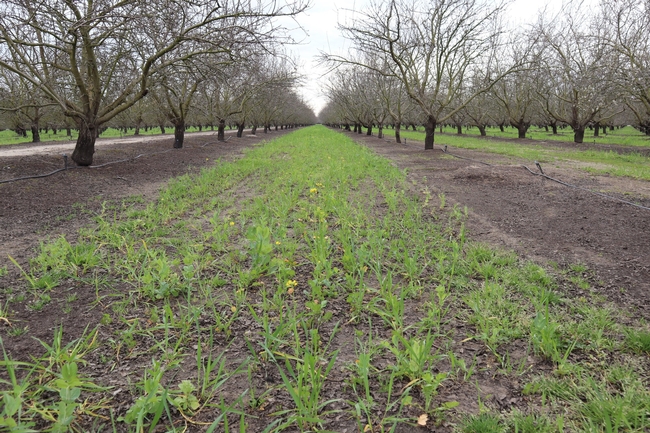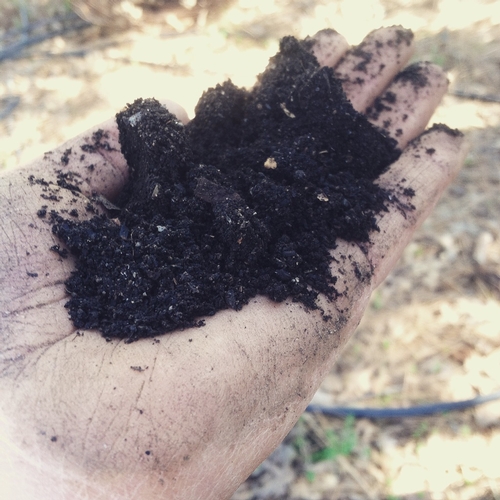
Posts Tagged: cover crop
$1.7M granted for climate-smart planning led by UC ANR scientists
In California, natural and working lands make up 95 million acres of the state and play a vital role in building resilience to the impacts of climate change. University of California Agriculture and Natural Resources was awarded $1.7 million for the California Next Generation and Equitable Climate Action Plan, as part of the state's Natural and Working Lands Climate Smart Strategy and California's 30x30 Initiative, an effort to conserve 30% of the state's lands and coastal waters by 2030.
Natural and working lands include both unmanaged and managed areas actively used for agriculture, forestry or production purposes.
Chandra Richards, UC Cooperative Extension agricultural land acquisitions academic coordinator for Southern California, and Cristina Murillo-Barrick, UCCE's Black, Indigenous and People of Color community development advisor for the Bay Area, are leading the California Next Generation and Equitable Climate Action Plan project.
To build capacity and technical assistance for climate-smart action planning, Richards and Murillo-Barrick will use the Climate Smart Land Management Program funding, awarded through the California Department of Conservation, to focus on two of the most pressing climate action issues: equitable land access and land management diversification.
According to the 2022 U.S. Department of Agriculture census, demographic data indicates that California agricultural land ownership and production is concentrated within an aging and mostly White demographic. However, research suggests diverse management practices promote healthy landscapes. This has been shown to benefit the environment, human health and climate resilience in multiple ways.
For this reason, this project centers on “historically underrepresented communities,” a term that includes California Native American Tribes, communities of color, landless farmers, immigrant and non-English speaking communities and other agency-designated minority groups (racial, ethnic and non-male groups, socially disadvantaged farmers and ranchers, and California designated severely disadvantaged communities).
Focusing on Southern California, UC Cooperative Extension scientists will identify barriers to land access, management and opportunities to increase land manager diversity. They also will engage historically underrepresented communities in coalition building, capacity assessment and climate action planning.
Within the last few decades, Californians have faced increased ecosystem stressors and decreasing diversity of natural systems. This pattern continues to damage already-vulnerable communities (disproportionately historically underrepresented communities), while also worsening and intensifying climate impacts, including drought, wildfire, flooding and disease. Overcoming these kinds of systemic and structural challenges will require the next generation of land managers to reflect California equitably, while preparing them to take on climate resilience. The project will determine clear solutions and plans that enable long-term, strategic land use and protection.
To do this work, UCCE is collaborating with the Community Alliance with Family Farms (CAFF), California Association of Resource Conservation Districts (CARCD) and the California Bountiful Foundation, all of whom serve as subgrantees and will deepen connections with communities.
Organizations like CARCD have long served as “boots on the ground” personnel and have close relationships with landowners and land managers. “RCDs have been hearing the land equity need for a long time and are actively collaborating with different partners to tackle this pressing issue,” said Qi Zhou, program manager of Justice, Equity, Diversity and Inclusion at CARCD and member of the Strategic Growth Council Land Equity Task Force.
“California RCDs are excited about this project because it will allow major California agriculture and conservation partners to collaboratively develop plans and implement projects centering on equity land access and land management diversification,” Zhou added.
Project lead Richards said $270,000 of the grant will be reserved for new partnerships with organizations in Southern California that have experience with, and strong ties to, historically underserved communities.
UC ANR is collaborating with the California Department of Food and Agriculture as well as California Climate and Agriculture Network (CalCAN), and World Be Well, a Southern California nonprofit.
Tawny Mata, CDFA's director of the Office of Environmental Farming and Innovation, described technical assistance providers as being grounded in their local agricultural communities and recognized their importance to partners in the success of CDFA's incentive programs.
“When we do succeed in reaching historically underserved farmers and ranchers with our grant programs, it is often with the thoughtful support and planning of a technical assistance provider,” Mata said. “I look forward to this project helping us refine our own technical assistance funding programs and bringing technical assistance providers together to network and share best practices for improving land access and promoting climate-smart agriculture.”
“The successes of this project will elevate the voices of historically underrepresented communities, strengthening efforts in these communities to support climate action,” said Richards. Additionally, the project will increase sharing of regional reports, needs assessments and community plans surrounding climate-smart management practices. Finally, it will boost technical assistance for these groups specifically.
To learn more about the Climate Smart Land Management Program and this year's awardees, visit:
Cover cropping season has begun: Free recorded webinars, demos available
Cover crops, typically planted in early fall, deliver a host of agricultural and conservation benefits. But many growers have gone away from planting them due to technical challenges and extra costs associated with the practice. In partnership with the Contra Costa County Resource Conservation District, two University of California Cooperative Extension advisors collaborated to support farmers' cover cropping efforts and reduce costs.
Kamyar Aram, UCCE specialty crops advisor for Contra Costa and Alameda counties, and Rob Bennaton, UCCE Bay Area urban agriculture and food systems advisor, developed online project content for a free educational series on cover cropping, which entails growing non-cash crops to add beneficial biomass to soils.
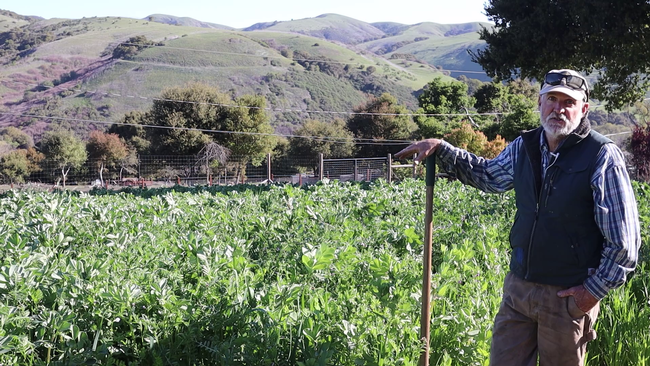
“Our site visit videos include a diversity of cropping systems, operation types and scales, and levels of experience with cover crops, so we really capture a variety of perspectives,” Aram said. “Now, with the videos online, I hope that they will serve as tools for other farm educators, as well as a resource for growers directly.”
When the COVID-19 pandemic scrapped plans for in-person workshops and visits, the series organizers pivoted to online webinars, starting in fall 2020, which drew more than 150 participants. The recorded videos – which cover basic methods, financial assistance, tips for orchards and vineyards and more – expanded the potential reach and impact of the series far beyond Contra Costa County.
“Each video, whether it's a webinar recording or a virtual site visit, emphasizes different aspects, and the titles are designed to help viewers find the resources they are most likely to benefit from,” said Aram. “There really is something for everyone.”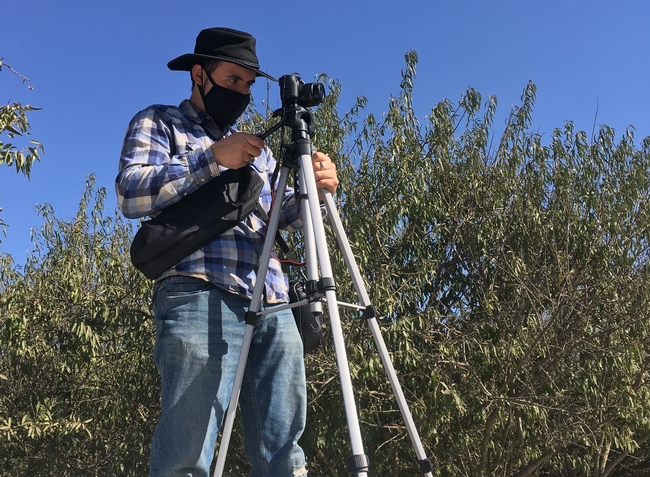
In particular, the organizers of the series recognized the importance of including technical and extension support to urban and semi-urban farmers in the East Bay and beyond.
“We wanted to make sure to include practical support from fellow farmers that was both accessible and relevant to our diverse small and urban farmers,” said Julio Contreras, UCCE community education specialist. “This meant covering topics like seeding with spreaders or by broadcasting – using small equipment and machinery or no-till systems – and even cover cropping in planter boxes.”
Aram and Bennaton also credited their Contra Costa Resource Conservation District partners: Ben Weise, agriculture conservation manager; Derek Emmons, agriculture conservation coordinator; and Chris Lim, executive director.
The project, funded by a Specialty Crops Block Grant from the California Department of Food and Agriculture, was also made possible by the generous contributions of time and expertise from presenters and hosts of farm-site visits, according to Aram.
“I hope that the videos will enjoy a long life online; they really contain a wealth of knowledge,” he said.
The series is available for view at http://ucanr.edu/CoverCropsCoCo.
Planning for Drought Resilience
A quick scan of drought related news is not good for my anxiety levels. A March 21st article in The Atlantic reports how our warmest winter in 100 years (by 4.4 degrees on average) is impacting agriculture across California: 17,000 farmers lost their jobs in 2014 and cost the ag sector $2.2 billion. For the first time in 75 years, the Department of Water Resources Sierra snowpack survey for April 1st had no snow to survey. The 2012-2014 California drought is reported to be the worst in 1,200 years! I am growing tired of watching the weather forecast as well. The pattern thus far: a storm is forecast, the storm arrives and delivers a fraction of what was expected. My new plan is to stop focusing on the lack of rain and snow and start getting serious about building drought resilience into our farm plan.
The reality is that we won't be able to sink a new well or dig a new pond. We are a small farm with very limited capital purchasing power. Does our lack of financial wiggle room mean that this drought may put us out of business? I am hopeful that we can continue to farm within the new parameters that this drought may impose on our business. But we won't be able to do this without a plan.
What is the worst case scenario on your farm or ranch? On my own farm, the worst case scenario would be the complete suspension of our irrigation water allotment. If our water allotment was drastically decreased, could we still make a profit from our farm? Here's a look at what we are planning to do to increase the drought resilience of our land and business.
A simple first step is to increase our soil organic matter. We traditionally grow both summer and winter cover crop on fallow ground. This summer's growing season, we are taking even more land out of row crop production and will plant more summer cover crops. Our favorite is sorghum Sudan grass. Unlike Johnson grass which it is very similar to in appearance, Sudan grass does not grow rhizomes and spread underground. It requires very little water and is a great way to protect open ground in the summer. According to UCCE Horticulture and Small Farms Advisor, Cindy Fake, a 1% increase in soil organic matter results in an additional 16,000 gallons of water retained per acre foot of soil! That is a lot of water. This ATTRA publication has a lot of information on creating drought resilient soils: http://cses.uark.edu/ATTRA_drought.pdf
Another goal this season is to understand exactly how much forage our pigs are able to access from the irrigated pastures we raise them on. I want to know exactly what it would cost if we had to buy in all of the feed for our animals. Understanding the financial impact that the loss of our irrigation water would have on our farm will help us make decisions about the size of our hog herd. If we decrease by 25%, can we keep our feed bill affordable? If there was no water at all, how much would it cost to keep our breeding animals alive?
We irrigate our row crops as efficiently as we can. We deliver water through drip tape and irrigate in the evenings once the day has cooled and evapotranspiration loss is decreased. But I am finding that this is still not enough to make our farm truly drought resilient. I need to know at what point in the growth cycle the crops I produce are most susceptible to water stress. In other words, how can I achieve profitable yields with the least amount of water possible? If I had to use my residential water supply to grow a crop, what is the least amount of water I could utilize without seriously impacting yield? Here is a link to a publication on water efficiency and the critical periods for water stress in orchard crops and vegetables: http://ucanr.edu/sites/placernevadasmallfarms/files/180093.pdf.
Understanding the economics of each of my crops is vital to drought resilience. I need to know which crops to prioritize in the face of limited irrigation water. Are dahlias or sunflowers a more profitable crop for us? Can we increase our early season production and limit production when the temperatures hit the high 90s? I cannot make these decisions without a thorough understanding of the income and expense associated with each crop. The crop metric calculators created by UC Extension can assist you in determining the profitability of each crop you grow. http://ucanr.edu/sites/placernevadasmallfarms/UCCE_Enterprise_Calculators/. By combining my understanding of which crops need water and when with my knowledge of income and expense for each crop, I can begin to create my drought contingency crop plan.
Out of habit, I just checked the weather forecast and saw that some rain is predicted for the end of the week. The predicted moisture will help the cover crop and pasture grow, but it won't alter the long term effects of this drought.
News links and References:
http://www.theatlantic.com/business/archive/2015/03/the-economics-of-californias-drought/388375/
http://www.water.ca.gov/news/newsreleases/2015/040115snowsurvey.pdf
Scott, H.D., L.S. Wood, and W.M. Miley. 1986. Long-term effects of tillage on the retention and transport of soil water. Arkansas Water Resources Research Center. Publication Number 125. 39 p.
Summer Cover Crops - Creating a Drought Resilient Farm
In the current, extreme drought we are experiencing in Placer and Nevada counties, making decisions about row crop production can be challenging. Many of us already employ water efficient irrigation techniques like drip and mulch. But drought planning on the farm needs to be a combination of dealing with current situations while also preparing for the high probability of future, and potentially more severe drought conditions. One production decision addresses both: growing a summer cover crop. By growing a drought tolerant, summer cover crop you can productively fallow land during the dry months to conserve water. A summer cover crop will provide a large addition of soil organic matter which will increase the water retention in your soil during future growing seasons. Cover crops also add nutrition to the soil and decrease weed pressure.
There are a number of great summer cover crops to try. Sudangrass (Sorghum bicolor) is a great choice for the foothills during the heat of summer. It requires an initial watering at planting but can be dry farmed once established. Take caution before grazing ruminants on sudangrass as it contains highly toxic prussic acid (hydrocyanic acid.) Sudangrass has lower concentrations of prussic acid than its relative Sorghum or Sorghum-Sudangrass hybrids but it is still present in the leaves and roots of the plant. Hogs and chickens are less susceptible to prussic acid poisoning.
Another great choice for a summer cover crop is buckwheat (Fagopyrum esculentum.) Buckwheat will also grow in very dry conditions once established. It creates wonderful forage for bees and beneficial insects, is very fast growing, and helps make phosphorous more available in your soils (http://www.sarep.ucdavis.edu/covercrop/res/1994-1996/other/mini-review). Buckwheat's broad leaves and fast growth make it an ideal “smother crop” that will effectively shade out problematic weeds.
Cowpeas (Vigna unguiculata) is a good legume choice for the dry summer. They will add a lot of nitrogen to your soils and will also help suppress summer weeds. Both buckwheat and cowpeas can be used as forage crops as well.
Grow a bed of summer cover crop or grow an entire field. Try a mix of species or just one type of plant. Whichever choice you make, summer cover crops will help you farm productively under the constraints of drought.
For more information on summer cover crops, check out these resources:
http://asi.ucdavis.edu/sarep/database/covercrops
http://www.ces.ncsu.edu/hil/hil-37.html

cowpeas and japanese millet

sorgum sudangrass
It is time to start watering the crops
Is it irrigation or irritation? That is the question I always ask myself this time of the year. March was too wet and now April has been too dry so it is time to get the water flowing on the newly planted crops. I farm in what used to be a walnut orchard. The good and bad thing about using a former orchard is that it comes with the permanent sprinkler system that was used to irrigate the trees. The good part is that the pipes are all underground and there is a riser pipe every 60 feet. The trouble comes when the cover crop really gets to growing and pipes that used to be easily visible disappear in the lush growth of the vetch, bell beans and rye.
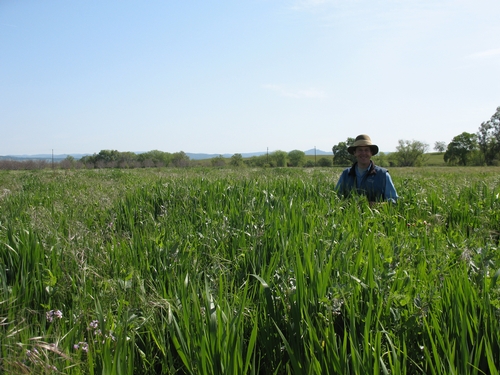
This year in addition to fixing the pipes I broke with the disc and mower, I am lowering all the riser pipes to a few inches below grade. This is my latest attempt at finding an easy way to farm the rows that contain the pipes. With the pipes below grade I can now take my mower or tiller right over the top of the pipes without breaking them (I hope). In the past I have just ignored the pipe rows and grown my crops in the alleys between, but I learned that is not a good idea. Two really bad things happen. First the weeds go nuts and sprawl all over the place, and second all the gophers and field mice move in to avoid the tractors and tillers going back and forth in the alleys. The rodents then stage nightly sorties into the alleys to chew on everything in sight. Not this year! This year I have a new plan. Now all I have to do is fix the irritation system so the plan will work. Did I say “irritation?” I mean “irrigation.”
The next week promises to be hard. I will be spending a lot of time on my hands and knees cutting pipes and gluing on new fittings. I am sure I will be making about fifty trips to the hardware store to buy more parts, especially the one part that I must have but forgot to buy the last time I was at the store. I would rather do this work now and conquer my pest problem in the beginning than trying to figure out a solution at the height of the growing season when I am lucky to think about anything other than picking and planting.

